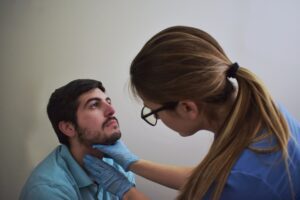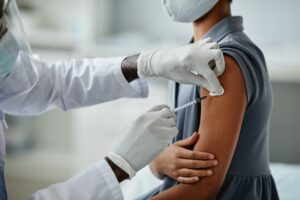

Call Us Today
(828) 505-7033
Email Us
info@advancedoccmed.com
Visit Us
1550 Hendersonville Rd Suite 200 Asheville, NC 28803

(828) 505-7033
info@advancedoccmed.com
1550 Hendersonville Rd Suite 200 Asheville, NC 28803

Welcome to the Advanced OccMed blog, where we specialize in occupational medicine and aim to optimize workplace health and safety. In today’s post, we will dive into the topic of respiratory protection and explore the importance of the respirator clearance/fitting exam in ensuring optimal respiratory protection for workers in various industries.
Respiratory protection plays a crucial role in safeguarding workers against airborne hazards encountered in the workplace. Whether it’s airborne contaminants, dust, gasses, or biological agents, employers have a responsibility to prioritize the respiratory health of their employees. By implementing appropriate control measures, such as the hierarchy of controls, employers can mitigate risks and create safer working environments.
The respirator clearance/fitting exam is a vital step in the process of ensuring proper respiratory protection. It is conducted by a certified healthcare professional to assess an individual’s suitability for respirator use. Compliance with legal and regulatory requirements, such as those set forth by organizations like OSHA, is essential to meet industry standards and protect workers effectively.
A comprehensive medical evaluation is a critical component of the respirator clearance/fitting exam. By reviewing an individual’s medical history, including respiratory conditions, allergies, and prior exposures, healthcare professionals can assess the potential risks and determine the most suitable respirator for each individual. Pulmonary function testing (PFT) may be included to assess lung health and ensure that individuals can safely use respirators without exacerbating any existing respiratory conditions.
Fit testing is another crucial aspect of respiratory protection. Its purpose is to ensure a proper seal between the face and the respirator, as an inadequate seal can render the respirator ineffective. Two main types of fit testing exist: qualitative and quantitative. Qualitative fit testing relies on the wearer’s subjective response to a test agent, such as saccharin or Bitrex. Quantitative fit testing measures the number of particles inside and outside the respirator to assess the fit. Various fit test methods, including the saccharin, Bitrex, irritant smoke, and ambient aerosol methods, are employed to evaluate respirator effectiveness.
Comprehensive training and education are essential for the successful implementation of respiratory protection programs. Proper training ensures that workers understand how to correctly don and doff their respirators, maintain and clean them, and store them appropriately. Ongoing education is crucial to keep employees informed about updates, new equipment, and changing regulations. By fostering a culture of respiratory protection, employers can create awareness and responsibility among their employees, leading to safer working environments.
Protection To optimize respiratory protection, several best practices should be followed. First and foremost, selecting the right respirator for the specific hazard is crucial. Conducting user seal checks, which involve verifying the proper fit and seal of the respirator before each use, is also essential. Additionally, proper hygiene practices, such as regular cleaning and disinfection, must be emphasized. Employers should develop robust respiratory protection programs that include regular equipment inspections, maintenance, and storage procedures to ensure the longevity and effectiveness of respirators.
Respiratory protection is a vital aspect of workplace safety, and the respirator clearance/fitting exam plays a significant role in optimizing respiratory protection for workers. By adhering to legal and regulatory requirements, conducting thorough medical evaluations, performing fit testing, and providing comprehensive training and education, employers can ensure that their workers are properly protected from airborne hazards. Prioritizing respiratory health is not just a legal obligation but a moral responsibility to create safe and healthy working environments.
We hope this blog post has provided valuable insights into the importance of the respirator clearance/fitting exam and its role in optimizing respiratory protection. If you have any questions or would like to learn more about our services, please don’t hesitate to contact us.
A respirator clearance/fitting exam is an evaluation conducted by a certified healthcare professional to assess an individual’s suitability for respirator use. It involves reviewing medical history, conducting pulmonary function tests, and ensuring a proper fit for effective respiratory protection.
The exam is crucial as it helps determine the appropriate respirator for each individual, taking into account their medical history, respiratory conditions, and potential risks. It ensures a proper fit and seal, maximizing the effectiveness of respiratory protection.
Any worker required to wear a respirator as part of their job duties should undergo a clearance/fitting exam. This includes individuals exposed to airborne contaminants, hazardous gasses, or biological agents in their workplace.
The exam typically involves a comprehensive medical evaluation, including a review of medical history and possibly pulmonary function testing. It also includes fit testing to ensure a proper seal between the respirator and the wearer’s face.
The frequency of exams varies depending on regulatory requirements and workplace hazards. Generally, clearance/fitting exams should be performed initially and then repeated periodically, typically on an annual basis or as recommended by healthcare professionals.
Yes, there are two main types of fit testing methods: qualitative and quantitative. Qualitative fit testing relies on the wearer’s subjective response to a test agent, while quantitative fit testing involves measuring the number of particles inside and outside the respirator to evaluate the fit.
No, it is important to ensure that the clearance/fitting exams are performed by certified healthcare professionals who are trained in respiratory protection and comply with relevant regulations and guidelines.
These websites provide valuable information and resources regarding respiratory protection, regulations, guidelines, and best practices in various industries.




